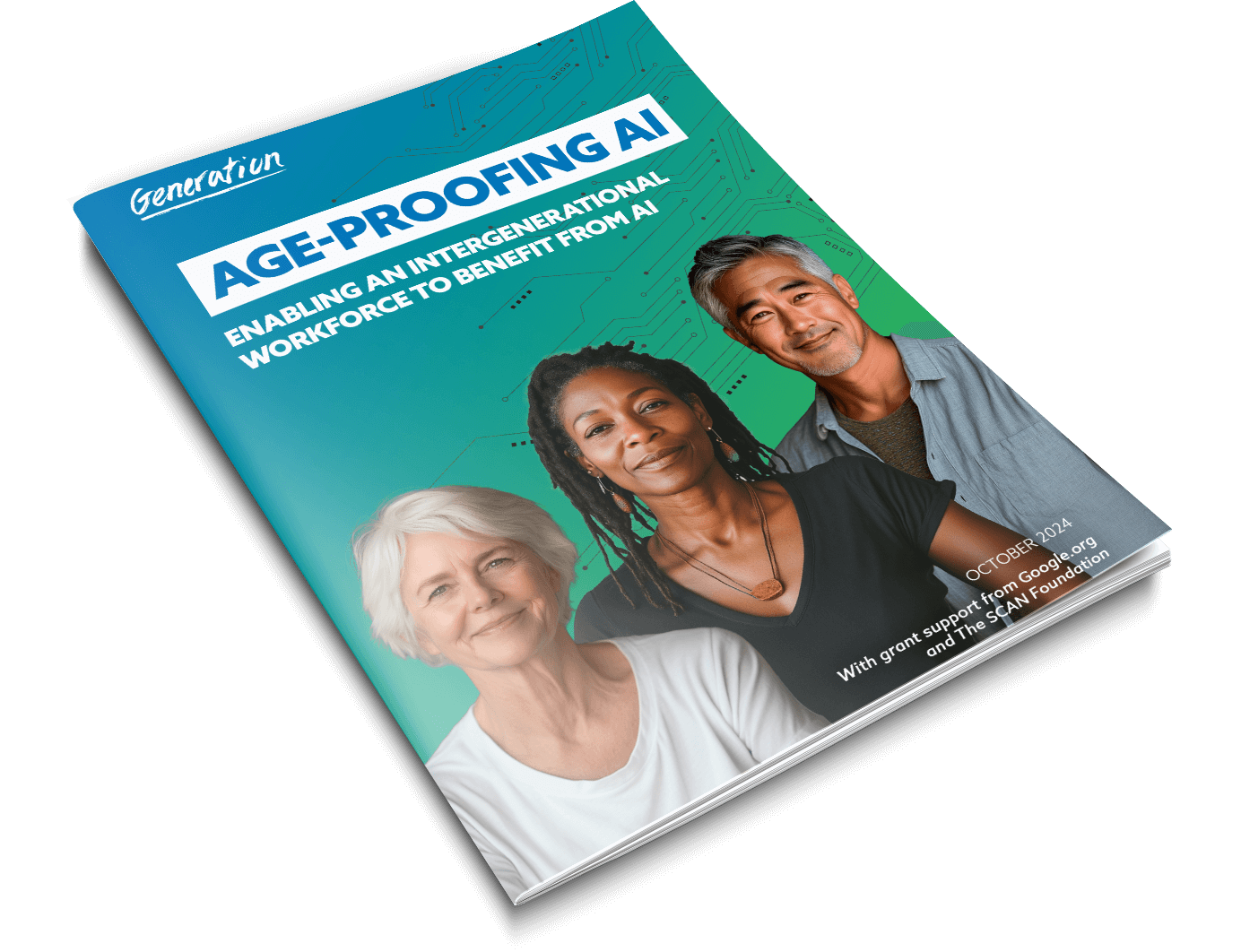Age-Proofing AI:
Enabling an intergenerational workforce to benefit from AI
Download Report
With grant support from
Google.org and
The SCAN Foundation

The AI revolution is fully underway.
We are all eager to understand what the future holds for the workforce, particularly for two of the fastest-growing age groups in the labor market: midcareer and older workers.
With grant support from Google.org and The SCAN Foundation, we commissioned YouGov to survey two audiences — people age 45+ who work in entry and mid-level roles, and hiring managers who evaluate candidates for these roles — across a range of industries and company sizes.
We surveyed 2,610 employees and 1,488 employers in France, Ireland, Spain, the United Kingdom, and the United States.
The survey explored the rollout and use of AI tools — specifically generative AI tools, or those capable of generating content such as text, images, video, audio, or speech.
Download ReportEmployers predict a sharp drop off in hiring, a likely amplifier of age bias.
Our survey found that US and European employers anticipate declines ranging from 22% to 64% over the next 12 months in their entry-level and mid-level hiring. This trend was consistent across sectors and company size.
A risk from this anticipated hiring slowdown is that in a competitive labor market, pre-existing age biases may become even more challenging to overcome for older workers seeking employment. Hiring managers in both the US and Europe told us they prefer younger candidates, expressing the belief we have seen before that, as they age, workers become less open to technology and new tools.
That preference for younger candidates intensifies when considering roles that regularly use AI tools — hiring managers are 3x more likely to consider job candidates under age 35 than those over age 60.


The low level of AI use among midcareer and older workers today may well be understating the growth potential
On the surface, it might appear these age biases are well-founded. On average, only 15% of workers age 45 to 65+ across both Europe and the U.S. reported that they were currently using AI in the workplace — ranging from 13% in the United States to 17% in Europe.
However, just because many older workers don’t currently use AI doesn’t mean they can’t. In fact, in our survey, among midcareer and older workers who have adopted AI tools, the majority are self-taught and “power users”.



Employers are missing the mark in doing what it will take to get the most out of AI, especially from experienced workers
Encouraged by early signs of improvements in productivity and job satisfaction, employers across all industries are deploying AI solutions at a rapid pace. Nearly half of U.S. hiring managers surveyed reported that their companies have started providing AI tools, and an additional 24% plan to do so in the next 12 months. While Europe’s transition is slower, change is underway there as well, with 29% of employers saying they currently provide AI tools and 31% planning to in the next year.
While change is underway, the majority of midcareer and older workers are still on the fence about the value of AI tools in the workplace. The ambivalence we see from workers in our survey is consistent with other recent research that found that it isn’t obvious to experienced workers how AI can fit into their work. This gap points to a need for employers to marry experience with skills to unlock the full benefit of AI — by finding use cases that incorporate AI into specific roles and experience levels.


These insights point to three calls to action
1. Employers
Employers need to do more to make the most of their experienced workers. Developing use cases that combine work experience with AI workplace tools, incentivizing employees already using these tools to mentor peers, and tracking data can all drive higher productivity.
2. Workers
Midcareer and older workers need to guard against relying on experience alone as the best way to stay employable. Actively pursuing AI skills and knowledge can help them achieve the winning combination of experience and skills.
3. Workforce Programs
Workforce programs that serve midcareer and older workers need to be retooled. They need to integrate AI skills into their programs and target both workers who need to reskill as well as those who need to upskill within an existing role.
When it comes to AI, workers age 45+ are an asset. Read the full research report to learn more.
Download Report*Most of these images were generated using artificial intelligence, on the Midjourney platform.
